Knowde Brand Summary
Identification
- Additives Included
- Fillers Included
- Technologies
- Product Families
- Plastics & Elastomers Functions
Features & Benefits
Applications & Uses
- Markets
- Applications
- Composites End Use
- Plastics & Elastomers End Uses
The NORYL family of modified PPE resins consists of amorphous blends of PPO™ resin (polyphenylene ether) and polystyrene. They combine the inherent benefits of PPO resin (affordable high heat resistance, good electrical properties, excellent hydrolytic stability and the ability to use non-halogen FR packages), with excellent dimensional stability, good processibility and low specific gravity.
NORYL resins offer a good balance of mechanical and chemical properties, and may be suitable for a wide variety of applications
Identification
Features & Benefits
Applications & Uses
Responding to the significant need for a change in the status quo, SABIC offers NORYL resins. These recyclable thermoplastics combine a smaller carbon footprint with the flexibility and processing performance of PVC. Exceeding the demands of the industry, NORYL resins also offer low specific gravity, faster processing and improved abrasion resistance.
The application of our advanced resin technology opens up the possibility for a more efficient future for the automotive and consumer electronics industries.
In the last three decades, the composition of automotive wire coatings has deviated very little from the norm. PVC materials are used for about 60 percent of automotive applications, with XLPE resins bringing enhanced high-heat performance where needed. With today’s vehicles requiring more than two and a half kilometers of wire, the environmental impact of these materials through dioxins and nonrecyclability can be devastating.
In the absence of a cost-effective, highperforming alternative, the automotive industry has struggled to improve its environmental record without sacrificing the quality of its products. With NORYL resins, manufacturers are no longer obligated to choose between a reputation of quality and a reputation of environmental consciousness - they can have both.
Flexible NORYL wire coatings are made with modified polyphenylene ether (mPPO) thermoplastic resin, an inherently lighter, tougher material than PVC. The specific gravity of NORYL resin is 1.03, which is lower than that of both PVC and XLPE. These superior qualities enable the creation of more compact wire bundles as well as significant weight savings in your application even when used in identical wire configurations. One tier 1 automotive supplier was able to reduce overall vehicle wire weight by as much as 25 percent.
Wire coated with certain flexible NORYL resin can meet the requirements for ISO 6722 class A, B, and C wire heat aging, and exhibits pinch and abrasion resistance up to 10 times better than wire coatings made from PVC. These high-performance materials also offer easier processing and faster throughput than XLPE, because they do not require cross-linking.
Not only does wire coating made from flexible NORYL resin outperform PVC and XLPE, it is also easier on the environment. NORYL resin provides non-halogenated flame resistance, and won’t release dioxins when burned like PVC. Unlike XLPE resins – which are effectively thermoset materials – wire coating made from flexible NORYL resin can be easily reclaimed, reground and has the potential for recyclability like many other thermoplastics.
From cell phones to refrigerators, consumer electronics have relied for decades on flame retardant PVC and polyethylene-based wire coating. Recently, the potential environmental and health hazards of these materials have become more and more evident. In addition to the toxins released when halogenated and/or brominated wire coatings burn, many conventional wire coatings may also contain potentially carcinogenic plasticizers.
Non-halogenated, flame-retardant flexible NORYL resin for wire coating is non-brominated, meets heavy metal free requirements and has the potential to be recycled. In addition to meeting existing regulations, such as RoHS and WEEE, the material has certifications under UL1581 specification for 80°, 90° and 105°C. Several customers are already testing flexible NORYL resin wire and have acquired style pages with the UL758 standard.
Just as the automotive industry stands to gain reduced vehicle weight from NORYL resin, the consumer electronics industry can enjoy comparable or better processing performance than conventional wire coating materials and halogen-free alternatives. Our wire coating materials also make the process of switching from PVC as easy as possible for our customers, as they can be extruded on existing equipment with little or no investment under appropriate conditions.
We realize that all aspects of technology are continuously evolving, which is why we are committed to the continued development of advanced wire coatings. In addition to our flexible NORYL resin wire coating technology, we also offer SILTEM™ resin, a high-heat PEI/siloxane copolymer based on SABIC’s ULTEM™ polyetherimide resin.
SILTEM resin is non-halogenated, generates very low smoke when burned and exhibits low corrosivity and toxicity – all qualities essential for plenum and other infrastructure applications. Together, these and other SABIC technologies open new opportunities for innovative wire coating applications.
NORYL glass filled (GF) resins show excellent dimensional stability when exposed to water at elevated temperature,as result of very low water uptake. NORYL GF resins have less than 0.3% water uptake when exposed to 90°C water compared to 5.3% for 35%GF PA 6.6. High water uptake is something that can negatively influence material properties and need to be carefully considered during design stage.
Long-term hydrolytic stability and good property retention when exposed to elevated temperature is another key benefit for NORYL GF resins.
Excellent resistance against chlorine at elevated temperatures is another benefit for NORYL GF resins which help ensure long-term property retention.
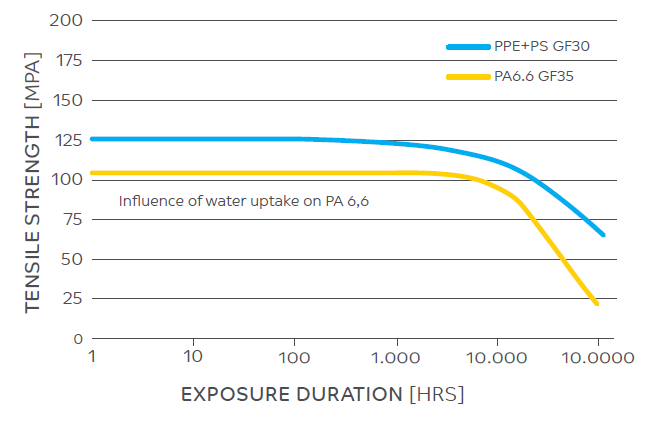
35% GLASS-FILLED POLYAMIDE 6.6 RESIN

Before chlorine exposure

After 1100 hours of chlorine exposure at 90°C
30% GLASS-FILLED NORYL RESIN

Before chlorine exposure

After 1100 hours of chlorine exposure at 90°C
Key aspects to consider when using VISCOSITY @ [300°C] NORYL™ GF resin in existing PA 6.6 mold are:
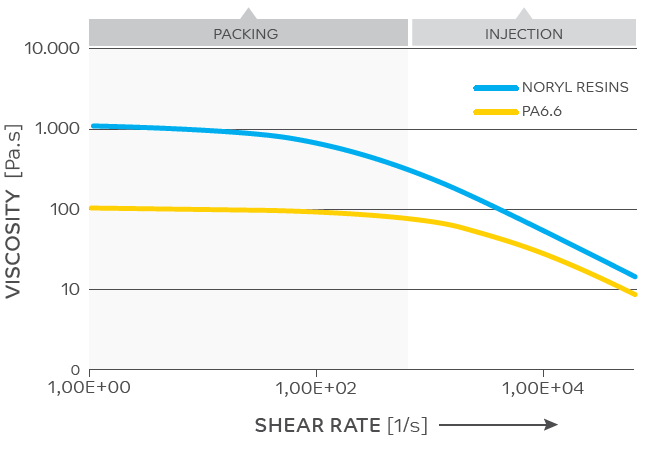
Local design modification are needed to reach equal performance with NORYL resins. Typical critical areas are weld lines, bolt connections and stress hot spots under continuous load. SABIC has developed anisotropic predictive engineering service to accurately predict part performance under various loads and temperatures.
Datasheet stiffness & strength values are best case scenario due to the favorable fiber alignment in direction to the load.
Quasi-isotropic material data are closer to the reality but do not take into account the
local variation of properties induced by the fiber orientation.
Anisotropic material models account for local fiber orientation and accurately predict the
part performance taking into consideration temperature and stress levels. This approach
can help optimizing cost and part performance.
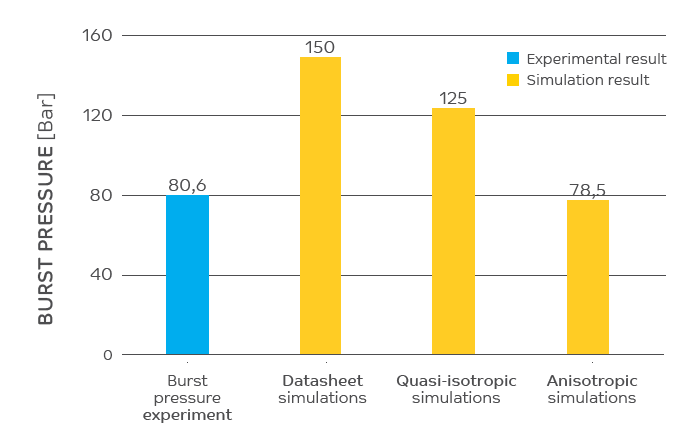
Chemical compatibility of thermoplastics is dependent on a number of criteria, including:
Amorphous polymers tend to be highly viscous and more susceptible to chemical attack vs. crystalline and semi-crystalline polymers, which are typically low viscosity and easier-flowing materials. Parts molded of crystalline resins will generally be lower stressed and more chemically resistant
In many industries, end-use applications have the potential to be exposed
to a myriad of chemicals and / or cleaning agents. This exposure may result in:
• Physical degradation – stress cracking, crazing, softening, swelling, discoloration
• Diminished performance – the reaction of the chemical with the polymer may result in
the loss of mechanical or other performance properties of the thermoplastic
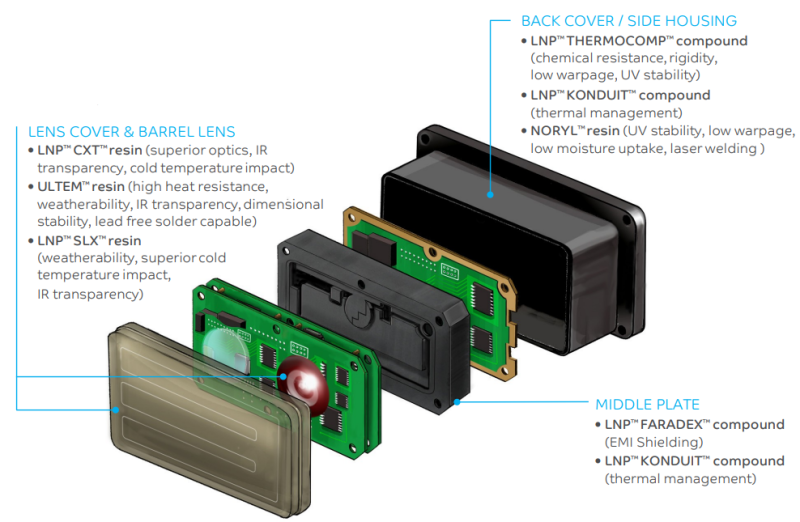
The NORYL family of resins represents combinations of SABIC’s innovative polyphenylene ether (PPE) technology blended with either high impact polystyrene (HIPS), polypropylene (PP), polyamide (PA) or thermoplastic elastomers (TPE), together with select additives and fillers. These blends were created to add value by combining the strengths of both resins in order to address critical requirements such as chemical resistance, modulus, and processability.
PPE
NORYL™ resin has been considered a material of choice for end-use applications in industries such as water management, healthcare and automotive interiors, where exposure to chemicals and cleaning agents is common. One of the most important application development and material selection considerations is the environment in which the end product will be used. This can include the effects of exposure not only to temperature extremes, but also to weather, UV rays, excessive moisture, solvents and chemicals.
Flame-retardant, High Strength Upper Enclosures
High voltage (>60 V) electric vehicle NORYL™ Resin, LNP™ VERTON™ and battery pack enclosures can LNP™ THERMOCOMP™ compounds contribute significant weight to the can offer the necessary qualities for overall battery pack, impacting its electric vehicle battery upper specific energy (Wh/kg). enclosures. Certain high performance Where ultimate strength is required, engineering thermoplastic materials customers may elect to utilize can replace traditional metals, UD-MAX™ tape in combination saving weight and easing the burden with appropriate base materials. of cumbersome processing.
Specialties’ dedicated CAE teams Depending on individual can work directly with you can work requirements, such as pack directly with you to help tailor dimensions, Specialties’ portfolio of a range of next-generation, materials including flame-retardant lightweight battery pack solutions.
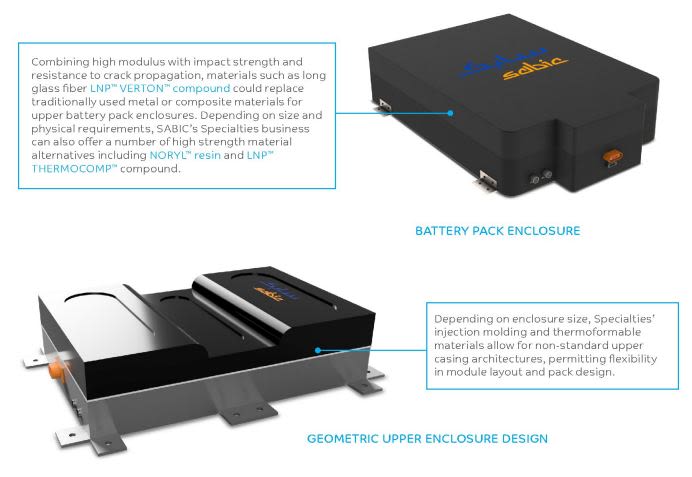
Lightweight Battery Pack Peripherals
Depending on material and design requirements, SABIC’s Specialties business can provide a number of materials for electric vehicle battery packs, including bus bar holders, covers, brackets, end plate assemblies and enclosures for battery management systems, control units, fuses and relays, etc.
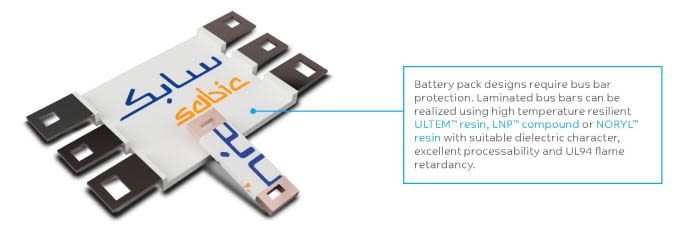
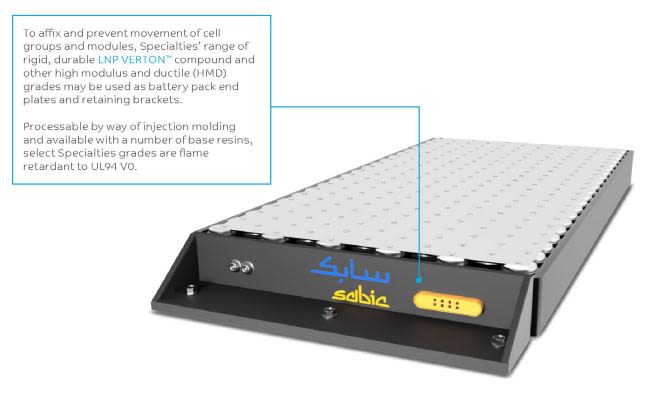
Injection Moldable, Flame-retardant Materials
Select Specialties injection-molding materials can be used in cell group/ module designs. Highly dimensionally stable and affording appropriate electrical insulation, our materials may be used in various spacing applications, terminal covers, housings and enclosures for prismatic cells and modules.
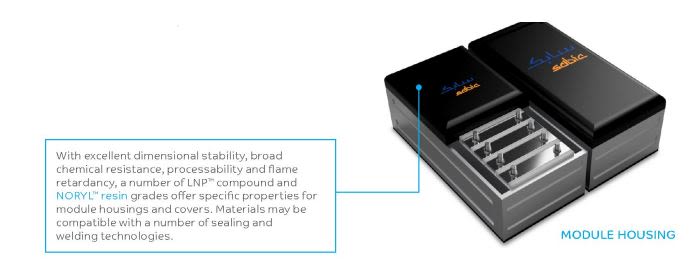

All-plastic 48 V Battery Enclosures
As the mobility industry faces growing pressure to increase fuel efficiency and reduce tailpipe emissions, the case for vehicle electrification grows ever more strong. Concomitantly, 48 V mild hybrid electric vehicles (MHEV), enabled by 48 V batteries, are poised to grow considerably in the coming years. Depending on crush requirements, 48 V Li-ion batteries may be constructed using all-plastic enclosures, helping battery designers to save weight. The Specialties portfolio contains a range of mechanically resilient, lightweight materials with added functionality such as UL94 flame retardancy and thermal conductivity that can aid passive cooling.
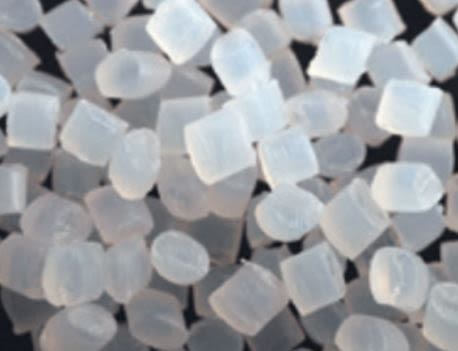
48-Volt Battery Case
Our range of LNP™ KONDUIT™ compounds offer thermal conductivity, thus can allow dissipation of heat build-up during battery operation. Select LVP™ ENH compounds and NORYL" resin grades offer nonchlorinated, non-brominated flame retardancy, together with 600 V (PLC 0) comparative tracking index (CTI).
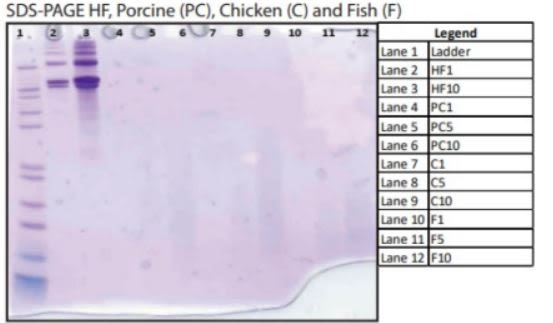
The importance of passenger, occupant and pedestrian safety is driving automakers and their suppliers to upgrade their ADAS offerings to further advance the performance and reliability of assisted driving. As adoption rates rise, the number of safety features and onboard electronic systems per vehicle increases each year, requiring engineers to seek out material solutions for light weighting and increased design flexibility.
Radar systems are an integral part of the ADAS system supporting features such as Adaptive Cruise Control (ACC), Automatic Emergency Braking (AEB) and Forward Collison Warning (FCW). Radar sensors constantly sense the distance between
vehicles in real-time to improve driving efficiency and safety. Therefore, these units require material solutions offering effective Electromagnetic Interference (EMI) shielding and radar absorption properties to ensure that cross-interference does not disrupt the various system components that protect drivers, passengers an,d pedestrians.
SABIC’s highly specialized thermoplastics can help engineers improve radar sensor technologies using materials that aid in light weighting, metal replacement and improved design flexibility. Providing automakers and their suppliers with high performance solutions to help them address the ever-changing ADAS landscape, as well as to identify potential system cost reductions.
Our portfolio offers:
SABIC Solutions for Radar Sensor System Applications
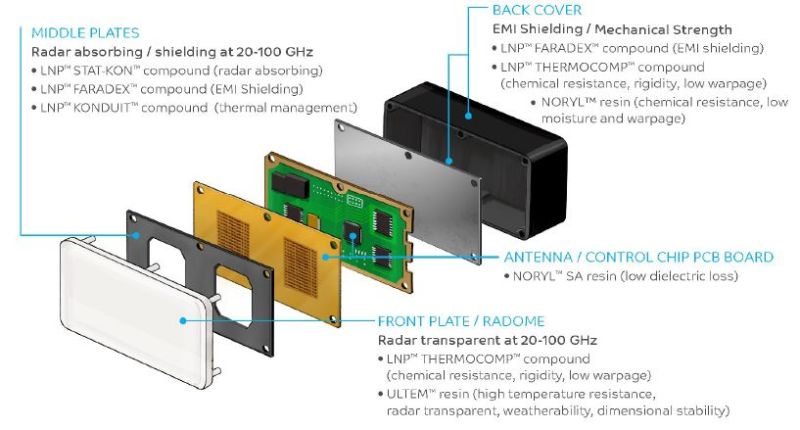
The table below shows a chemical resistance comparison for three NORYL™ resin product families. Tensile behavior before and after immersion was tested. Within each product family, there may be individual compounds that behave differently, especially in end products that are subject to high internal stresses due to the processing technology used in their manufacture.
| CHEMICAL | NORYL Resin PPE+HIPS Amorphous) |
NORYL GTX™ Resin PPE+PA (Semi-crystalline) |
NORYL PPX™ Resin |
| Acids | |||
| Inorganic | + | • | + |
| Organic | + | • | + |
| Oxidizing | + | • | + |
| Alcohols | + | + | + |
| Alkalis | + | + | + |
| Amines | –/• | - | +/• |
| Automotive fluids | |||
| Greases (non-reactive organic esters) | •/+ | + | + |
| Oils (unsaturated aliphatic mixtures) | •/+ | + | + |
| Waxes (heavy oils) | •/+ | + | + |
| Petrol | – | + | + |
| Cooling liquid (glycol) | + | + | + |
| Brake fluid (heavy alcohol) | + | + | + |
| Condensates & Condensate fumes | – | - | + |
| Detergents, Cleaners | •/+ | ++ | + |
| Esters | + | + | –/• |
| Ethers | • | + | • |
| Free Chlorine | + | • | • |
| Hydrocarbons | |||
| Aliphatic | •/– | + | + |
| Aromatic | - | + | +/• |
| Fully | - | + | +/• |
| Partly | - | • | +/• |
| Ketones | - | • | +/• |
| Phenols | - | • | +/• |
| UV *color shift (light colors) | • | -/• | –/• |
| UV *mechanical property retention | ++ | + | + |
| Water cold + hot, < 80°C | ++ | - | –/• |
Key
| ++ | Very good |
| + | Good |
| • | Fair |
| – | Poor |
| n | Not tested |